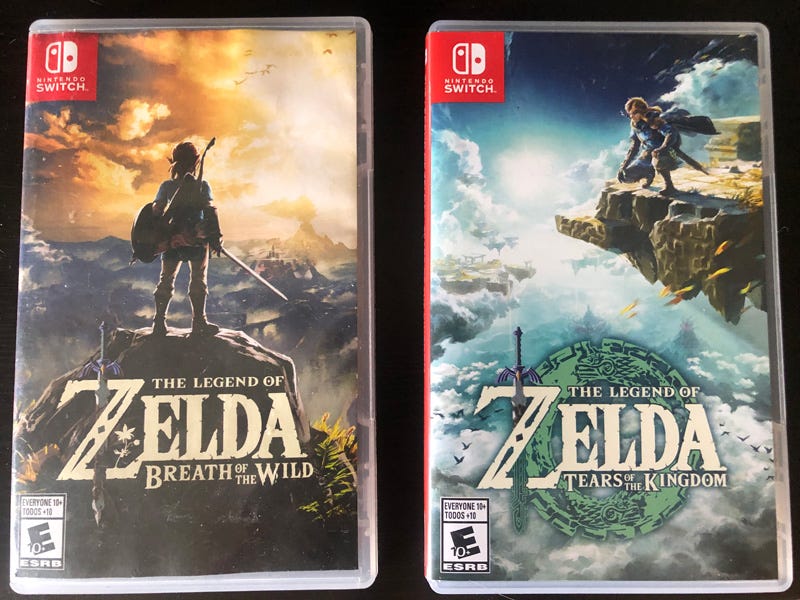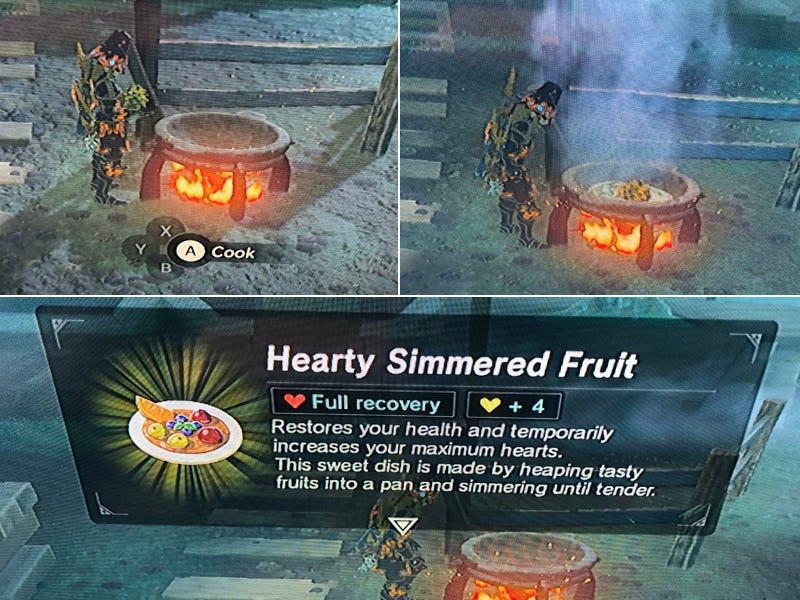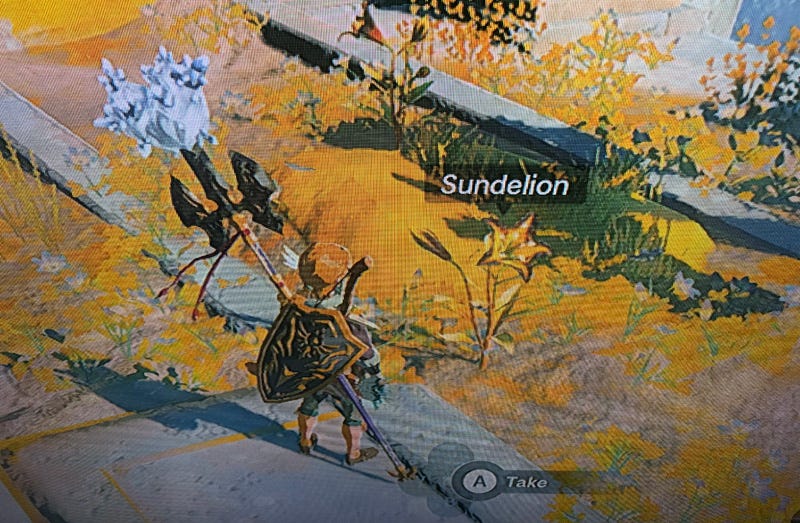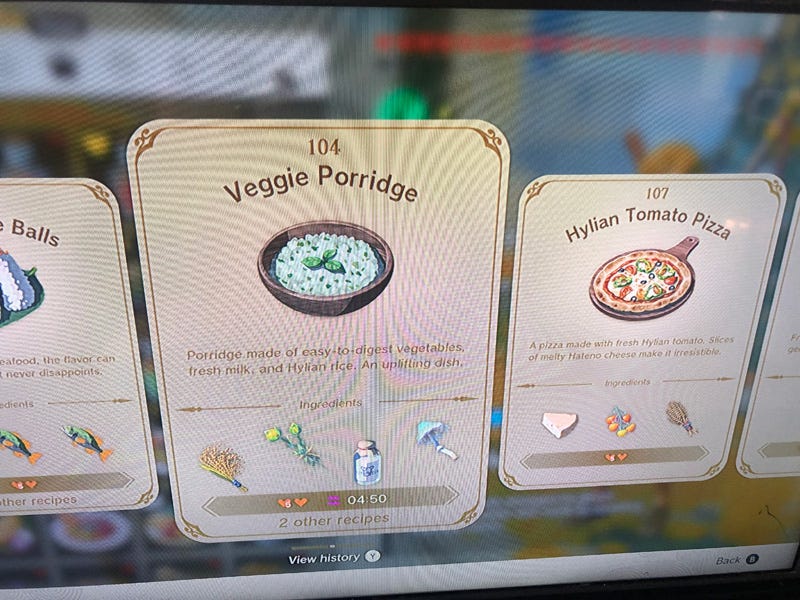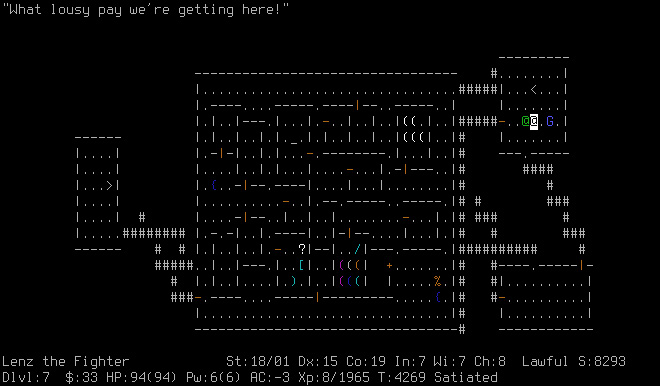THE COOKBOOK TEST #0006: TEARS OF THE KITCHEN
INSTALLMENT #0006 (FREE) / COOKING IN LEGEND OF ZELDA: BREATH OF THE WILD AND LEGEND OF ZELDA: TEARS OF THE KINGDOM
Dear Readers,
This week is a bit of a palate cleanser - the “cookbook” is a cooking system within a pair of high-profile video games. I want THE COOKBOOK TEST to have some flex to it, so that it’s able to tackle giant piles of new and vintage cookbooks but also mix it up with thoughts about other ways to codify and document cookery - online collections, games, periodicals, you name it. And I’ve cooked a lot of durians in LEGEND OF ZELDA: BREATH OF THE WILD, so it’s time to get some mileage out of that.
at your service,
James
LEGEND OF ZELDA: BREATH OF THE WILD
NINTENDO SWITCH
NINTENDO | 2017 | $50
LEGEND OF ZELDA: TEARS OF THE KINGDOM
NINTENDO SWITCH
NINTENDO | 2023 | $60
I’m not breaking any new critical ground when I say that Legend of Zelda: Breath of the Wild is a strong contender for best video game ever created, with no qualifications necessary. The 2017 game is truly immersive, dropping the player into an open world filled with vivid topography, weather, characters, stories, and stunning sights that can be experienced in just about whatever order the player chooses. It takes a lot of initial inspiration from The Elder Scrolls: Skyrim (2011) but from sound design to gameplay to sheer depth and size, it’s a quantum leap forward.
Its sequel, Legend of Zelda: Tears of the Kingdom (2023), is also mind-blowingly huge and impressive, and contains an ornate depth and sheer size that makes the original - itself ambitiously big - seem cutely manageable by comparison. That scale (provided in large part by developing a new world of floating islands and a new sprawling underground world of chasms) is a real selling point. For me, however, it just makes the first game seem all the more charming and better in terms of being an artistic whole - there’s a lot of TotK that feels like additional detail just to make a huge world that much huger.
Neither game is perfect - characters (particularly the female ones) seem paper thin, the plot scrupulously avoids anything legitimately provocative or gnarly (economic exploitation, racism, resource exhaustion, dictatorship), and the games’ attempt to empower Princess Zelda into a character with her own mind and abilities is hamstrung by the creators’ even stronger instincts to keep her in her fancy cage - another lovely young princess aching to be rescued by her gallant knight. I understand the appeal of a mousy, paper-thin baseline plot (Chinese government censors set a pretty robust tone for major intellectual property developed by anyone anywhere these days), and I understand the marketing power of “handsome knight saves sexy princess while galavanting around meeting other interesting women in the meantime,” but both decisions push these games away from “art” and towards “commercially viable entertainment.” Not a real complaint - with hundreds of millions of dollars on the line, it makes sense that recouping the investment comes first. Little indie titles can take the artistic risks.
Both recent Zelda titles are made rich in part by systems within systems that fill out their worlds. Horses have their own behaviors and attributes and interact with a stable system that stretches across the map. The weather changes regularly, and can affect your health (or ability to climb slippery surfaces.) And the plants and animals that populate Hyrule can be harvested and made into all sorts of elixirs (to enhance various abilities or grant various protections) or recipes (to restore health, and sometimes do some enhancing / protecting of their own.)
For example: I was pleased to discover that I could make a veggie soup using milk, salt, and endura carrots to restore a great deal of stamina, and I made a practice of mining for rock salt and buying or otherwise obtaining milk whenever I could to keep myself stocked in soup. Then my son (who was 7 or 8 at the time) asked: “What if you just cook the carrots?” Well, I said, that would be a lot cheaper and easier to do, but surely they wouldn’t grant much of a bonus without being in a fancy recipe. I tried it to prove my point. I did not prove my point. The salt and milk were basically pointless, as was the soup recipe; cooked carrots, by themselves, were powerful stamina restorers.
A similar thing happens with the game’s many, many, many different recipes that restore hearts. You can gather a rich variety of fish, meats, fruits, and other things to make all manner of skewers, pies, stews, pilafs, or curries. Or: you can go to one specific location conveniently near the Faron tower and just pilfer about 20 durians. And cook each durian, which even more conveniently restores 100% of your health, +4 bonus hearts.
Why roam the land questing for rare beasts and clever recipes when all you need to do is eat durians - and only durians - for the entire game? I never found an answer, and subsisted almost exclusively on the spiky primitive jungle fruit for the majority of my playthroughs. One can only imagine what Link’s bathroom experience might be while on an all-durian diet. (On second thought, it’s probably better not to imagine.)
The Legend of Zelda: Tears of the Kingdom cooking system suffers from some of the same problems as Breath of the Wild but to a lesser degree. Durians are nerfed out of existence. You can’t find ‘em anymore. They’re extinct! And while you can still find things that restore all your hearts plus some bonus hearts (like radishes and hearty truffles) they’re rare indeed. Radishes mostly (or entirely) can be found on sky islands, which are kind of hard to navigate to by their very nature.
And while cooling or warming armor exists and makes most of the cooling or warming foods redundant quite quickly, the game introduces a new Gloom mechanic - if you take damage while in the massive underground world called the Depths, you lose the ability to heal that damage until you get back to the surface world, sit under a glowing Lightroot, or eat food made from Sundelions, which undo the Gloom’s effect. So: Sundelions are a precious commodity, and the game’s final boss fight against Ganondorf requires quite a few of them unless you’re a remarkably dextrous fighter with a perfect command of the shield (I am not.)
Like most of TotK, the cooking system is more baroque than the one in BotW. And unlike most of TotK, I think that’s for the best - it makes gathering and utilizing ingredients feel fun and important, not like a mostly pointless sideshow. Cooking is entertaining in both games, but much more integrated into the actual game in TotK, where it serves as a guidepost to how other games can making cooking a way to skillfully and colorfully tie together terrain, wildlife, and character health in one important sub-system in a game full of them.
GO FORTH AND SEEK OUT ...
Nethack. This truly ancient ASCII-based dungeon-crawling RPG is in many ways the great-great-great-granddaddy of the Zelda franchise, and is shockingly entertaining on its own. It’s got a ton of real depth (items and monsters with surprising powers, many of which do unexpected things when combined) and while there’s no cooking per se, different monster corpses convey different powers upon your character after you eat them. (My favorite might be that eating a leprechaun causes you to teleport at random for a while.)


